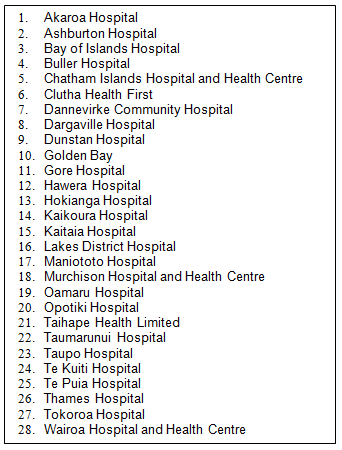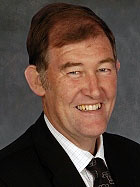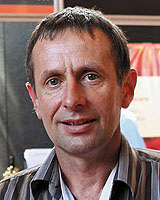The issue of the sustainability of rural hospitals in New Zealand is a perennial problem1-4. Shortages of doctors, funding crises, falling populations and increasing specialisation of health services have led to the centralisation of many services to hospitals in larger centres. Over the last 20 years a number of hospitals have been closed or the facilities handed over from health boards to community trusts3. With the loss of specialists from many hospitals, and the de-establishment of the medical superintendent role in the early 1990s, the responsibility for clinical governance of rural hospitals has also been moved, in many, instances to the base hospitals5. In 2009 the Medical Council of New Zealand (MCNZ) approved Rural Hospital Medicine (RHM) as a vocational scope of practice and approved the College of General Practitioners as the body responsible for developing an educational framework for doctors wishing to enter this scope of practice6. This move opens the way for generally registered rural hospital doctors to achieve vocational registration, and for those already registered in general practice to gain recognition and support for their hospital-based skills. It is hoped that this new initiative will improve the recruitment and retention of rural hospital doctors and provide a cadre of clinical leaders who will take responsibility for the clinical governance of their health services.
This study was performed in order to survey rural hospitals in New Zealand and characterise their current medical workforce, and to ascertain current governance arrangements to ensure standards of care are maintained. In addition, rural doctors who provided services to these hospitals were surveyed to discover their future scope of practice intention. The results should provide a baseline for assessing the impacts of future initiatives, including the recent changes to vocational registration.
This cross-sectional study was conducted in 2009 by the New Zealand Institute of Rural Health with cooperation from the Division of RHM. Formal ethics approval was not sought for this survey as it did not include any patient contact or details, and the responses from the individual doctors and the hospitals involved were all anonymised.
Initially, rural New Zealand hospitals that provided 24 hour hospital care, had medical cover and were included on the MCNZ list of rural hospitals approved for registration in the new scope of RHM were identified. The MCNZ had determined that hospitals with specialists in more than one specialty were regional hospitals and so these were excluded from their list of rural hospitals6. Hospitals that provide no emergency cover or those that provide residential care only were also excluded. Hospitals that provide long-stay care and/or maternity care only and have no medical cover for the care of acute undifferentiated patients from the community were also excluded (approximately 16 rural hospitals). The list of hospitals for survey was developed in conjunction with district health boards and the rural doctors' network.
Twenty-nine hospitals were surveyed by mail; however, one of these (Whangaroa Hospital) serves a very small population and was subsequently excluded because 24 hour cover of the 2 hospital beds was not always available. Consequently, data supplied by 28 hospital managers were analysed. These managers identified the doctors providing medical cover in their hospital in 2009, including those they employed and those working under a contractual arrangement. The identified doctors were then mailed an additional questionnaire. Data from the publicly available MCNZ register were used to verify doctors' registration status, and the year and university of their basic qualification.
Hospital managers survey
All 28 hospital surveys (100%) received from identified hospital managers were analysed. Eighteen of the 28 hospitals (64%) directly employed medical staff. The managers of these hospitals stated they had 80.9 budgeted full time equivalent (FTE) generalist and 4.2 FTE specialists positions. At the time of the survey, 53.9 FTE staff (66% of available positions) were employed as were 19.5 locums; 7.5 FTE positions were unfilled. The specialist positions were all filled.
Of the 28 hospitals, 15 were owned and managed by a District Health Board (DHB), 11 were owned by community trusts, one was a limited partnership and one was a local authority trading organisation. Fourteen of 18 hospitals (77%) that directly employed doctors reported a credentialing process for verifying qualifications and references etc prior to employment.
Twenty-six rural hospital managers answered the question about the availability of suitably qualified medical staff with 18/26 (75%) reporting a serious or a critical shortage and eight reporting a shortage. Regarding the availability of locums, only two respondents reported an adequate supply, with most saying there was a serious or critical shortage.
Ten of 28 managers (35%) reported that their facility had no designated medical leader (eg clinical director). Similarly, 10/28 reported there was no active process of clinical governance.
Registration status of doctors in 2009
Of the 107 doctors identified who provided medical services to the 28 rural hospitals, 27 (25%) were female. The median year of graduation was 1985. Thirty-eight (35%) were New Zealand trained (10 from Auckland and 28 from Otago). Of the 69 who were international medical graduates (IMGs), 31 (45%) had trained in the UK while 28 (41%) were trained in South Africa, Australia or North America. Fifty-eight (54%) were vocationally registered, 45 were generally registered and four were working under provisional registration. Of those who were vocationally registered 31/58 (53%) were GPs, 15/58 (26%) were vocationally registered in the new scope of rural hospital medicine, eight were registered with the Accident and Medical Practitioners Association (AMPA) and four were registered as hospital specialists. There was considerable overlap between these vocational scopes and many doctors were registered in more than one.
Doctors' survey
Sixty-nine of the 107 doctors (64%) surveyed responded and their characteristics were similar to the total - that is, 19/69 (27.5%) female, median age 47 years and median year of qualification 1985. Thirty-two per cent were New Zealand graduates. However 62/69 (90%) had permanent employment suggesting that locums were under-represented among the respondents. Thirty-five (51%) noted they had worked additional shifts in the last month to cover shortages in the hospital.
Only 29/69 (42%) said they were allowed regular, guaranteed non-clinical time. Interestingly only 36% DHB staff had guaranteed non clinical time compared with 44% of non-DHB employees and 39% full time workers compared with 43% of part timers.
In answer to the question 'Is there any formal medical leadership (eg clinical director) in your hospital?', 23/69 (33%) said 'yes', although when categorised according to hospital, there were positive responses from 14/27 (52%) of hospitals. Forty-two doctors said there was no formal medical leadership. Comments included statements such as:
From Chief Medical Officer indirectly and distantly.
I think the physician who visits once a week is probably the clinical director.
No formal leadership but easy access to clinical leadership from base hospital.
Similar responses were obtained when asking about clinical governance and credentialing. In all, 34/69 (49%) said they had a process of clinical governance and 36/69 (52%) or 18/27 (67%) hospitals said there was credentialing of medical staff.
Discussion
When discussing the staffing of rural hospitals it is important to define 'a rural hospital'. Janes in 1999 identified 36 rural hospitals but excluded Taupo, Tokoroa, Thames, Oamaru, Kaitaia and Ashburton, which at the time were 'specialist hospitals'. While at the time of the present survey 4 of these hospitals still had a vocationally registered specialist providing care, this was only in a single specialty and all 6 hospitals are included in the MCNZ list of rural hospitals. Fifteen of Janes' hospitals have either closed or are now residential care facilities with no acute beds2. Williamson et al recently identified 44 potential rural hospitals but only obtained 31 responses to their survey, and 28 hospitals indicated they handled a range of acute conditions7. Thus the present sample of 28 hospitals is a relatively complete picture of the provision in 2009. The diversity of roles carried out by rural hospitals - for example elderly care, GP short stay facilities, emergency room care and maternity care will continue to make classification difficult. The main defining characteristics used in the present survey were that the hospitals were rural and had beds which received acutely ill patients who would be managed by a generalist.
The present survey of hospital managers identified that there was a serious/critical shortage of appropriately qualified doctors available to work in rural hospitals. While these classifying terms could be considered subjective they do indicate the hospital managers' perception of need, a perception supported by the 10% unfilled positions and 25% filled by locums. While this has been raised as an issue previously6, this study has quantified the extent of the problem. The survey also revealed that acute hospital care is being provided in many cases by hospitals owned and run by community based organisations. It is of interest to note that the 'neo-liberal, market driven' policies of the 1990s have reversed the intent of the 1938 health reforms3 which nationalised hospitals and removed them from local ownership. Also, the usual safeguards associated with devolving services from state control have not been rigorously applied - that is, strong regulations to ensure the quality of care provided by the new owners. This is evidenced by the fact that many of the hospitals are not credentialing their medical staff and do not have an active clinical governance structure. However this is also true of some of the hospitals owned by the DHB. As the Minister of Health noted, there is a need for greater clinical leadership - and this appears to be particularly true for the rural hospitals8. Williamson said 'the capability of local clinical governance to provide a clear vision and strategy of service development appropriate to their population's need is also important'7. Some form of credentialing of staff is particularly important in rural hospitals where there is a high turnover of staff, and use of locums and IMGs. While IMGs play a critical role in keeping rural health services operating in many countries6,9,10, they also often require initial supervision and additional support10. Recent high profile cases from other countries also highlight the importance of proper assessment and supervision of IMGs working in rural hospitals or out of office hours11,12.
The present survey identified only 107 rural hospital doctors who are providing acute care in the 28 rural hospitals, a very vulnerable base from which to be operating such an important service. Hospital managers identified a continuing critical shortage of medical practitioners available to work in New Zealand's rural hospitals. Another sign of the lack of capacity is that 50% of the doctors had been required to work additional shifts in the month prior to the survey. It was also noted that a high proportion of IMGs was identified - 65% compared with the national figure of 41%, 42% for GPs as a whole13 or 57% for rural GPs14. The doctors also had a higher average age at 47 years compared with the national average (40 years)13. That many rural hospital doctors have been trained in other countries, coupled with the high proportion of doctors who are not currently vocationally registered, suggests a need for greater emphasis on the governance of rural facilities.
The doctors' questionnaire revealed a number of disturbing factors - the doctors also noted a lack of leadership, many reporting that they had no protected non-clinical time and that clinical governance processes were often rudimentary. When they first met in 2005, New Zealand's rural hospital doctors concluded that the absence of a professional body and training program were the greatest barriers to recruitment, retention and standards of care6. Now that these doctors have their own professional 'home' within the Royal New Zealand College of General Practitioners (RNZCGP)and the first registrars have entered the new training program there is the prospect that some of the problems highlighted in the present article may improve.
Murdoch identified the need for a clinical network of rural hospital doctors4. Now rural hospital doctors have a recognised scope of practice within the RNZCGP (Division of RHM). Murdoch also raised the issue of an academic base for RHM. This has been recognised by the Division who have insisted that the training program include a significant proportion of academic study. In addition, rural hospitals have renewed their participation in the training of medical students on a number of sites, due to rural immersion programs commenced by New Zealand's two medical universities (at Auckland and Otago)15,16.
It has to be said that the research base for RHM has been limited in New Zealand. Despite this a growing body of knowledge has been built up by a small but dedicated band of researchers17-21.
Murdoch also noted the need for leadership on the issue of out-of-hours provision in rural areas4. More work on the principles and issues involved in this difficult area needs to be undertaken and the Division of RHM should be involved in these discussions. Because RHM is a new scope of practice with an active experiential pathway, the number of vocational registrants is still steadily increasing. By July 2010 there were 38 doctors on the register and this is expected to plateau at approximately 50 doctors by the end of 2011 and to increase further when the current registrars start completing their training program in 2013.
This study provides useful baseline information for rural hospital managers, clinical leaders, DHBs, Health Workforce New Zealand and others involved in New Zealand workforce planning. The initiatives outlined should improve many of the sector's problems; however, their actual impact should be evaluated. Further research is needed on the strengths and weaknesses of differing models of care, for example comparing community ownership with ownership by a DHB. In addition, DHBs should assist in supporting New Zealand rural hospitals to develop robust and sustainable processes to underpin the clinical governance of their health services.
Acknowledgements
The authors thank all the hospital managers and rural hospital doctors who responded to the survey. Also thanked is Ellieda Komene from the New Zealand Institute of Rural Health who collected and collated responses.
References
1. Tranter D. Elegy for country hospitals. Nursing New Zealand 1994; 2(1): 13-15.
2. Janes R. Rural hospitals in New Zealand. New Zealand Medical Journal 1999; 112(1093): 297-299.
3. Barnett R, Barnett P. "If you want to sit on your butts you'll get nothing!" Community activism in response to threats of rural hospital closure in southern New Zealand. Health and Place 2003; 9(2): 59-71.
4. Murdoch JC. Medical opportunity of special scale? The future of rural hospitals in New Zealand? New Zealand Medical Journal 2007; 120(1259): U2655.
5. Williamson M, Gormley A, Farry P. Otago rural hospitals study: what do utilisation rates tell us about the performance of New Zealand rural hospitals? New Zealand Medical Journal 2006; 119(1236): U2030.
6. Nixon G, Blattner K, NZ Rural Hospital Doctors Working Party. Rural hospital medicine in New Zealand: vocational registration and the recognition of a new scope of practice. New Zealand Medical Journal 2007; 120(1259): U2654.
7. Williamson M, Gormley A, Dovey S, Farry P. Rural hospitals in New Zealand: results from a survey. New Zealand Medical Journal 2010; 123(1315): 20-29.
8. Ministerial Task Group on Clinical Leadership. In good hands - transforming clinical governance in New Zealand. Wellington: Ministry of Health, New Zealand, 2009.
9. Health Workforce Queensland and New South Wales Rural Doctors Network. Medical practice in rural and remote Australia: combined rural workforce agencies national minimum data set report as at 30th November 2008. Brisbane, QLD: HWQ, 2009.
10. Hagopian A, Thompson MJ, Kaltenbach E, Hart LG. The role of international medical graduates in America's small rural critical access hospitals. Journal of Rural Health 2004; 20(1): 52-58.
11. Casali GL, Day GE. Treating an unhealthy organisational culture: the implications of the Bundaberg Hospital Inquiry for managerial ethical decision making. Australian Health Review 2010; 34(1): 73-79.
12. Cosford PA, Thomas JM. Safer out of hours primary care. BMJ 2010; 34: 25-27.
13. Medical Council of New Zealand. The New Zealand Medical Workforce in 2009. Wellington: Medical Council of New Zealand, 2010.
14. Goodyear-Smith F, Janes R. New Zealand rural primary health care workforce in 2005: more than just a doctor shortage. Australian Journal of Rural Health 2008; 16(1): 40-46.
15. Poole P, Bagg W, O'Connor B, Dare A, McKimm J, Meredith K, Shulruf B, Reid P. The Northland Regional-Rural program (Pukawakawa): broadening medical undergraduate learning in New Zealand. Rural and Remote Health 10: 1254. (Online) 2010. Available: www.rrh.org.au (Accessed 31 March 2011).
16. Farry P, Adams J, Walters L, Worley P, Dovey S. Development of the Rural Immersion Programme for 5th-year medical students at the University Of Otago. New Zealand Medical Journal 2010; 123(1323): 16-23.
17. Blattner K, Nixon G, Dovey S, Jaye C, Wigglesworth J. Changes in clinical practice and patient disposition following the introduction of point-of-care testing in a rural hospital. Health Policy 2010; 96(1): 7-12
18. Scott-Jones J, Lawrenson R, Maxwell N. Sharing after hours care in a rural New Zealand community - a service utilization survey. Rural and Remote Health 8: 1024. (Online) 2008. Available: www.rrh.org.au (Accessed 31 March 2011).
19. Williamson M, Gormley A, Farry P. Otago rural hospitals study: what do utilisation rates tell us about the performance of New Zealand rural hospitals? New Zealand Medical Journal 2006; 119(1236): U2030.
20. Fearnley D, McLean J, Wilkins G, Restieaux N, Nixon G. Audit of a collaborative care model suggests patients with acute myocardial infarction are not disadvantaged by treatment in a rural hospital. New Zealand Medical Journal 2002; 115(1165): U239.
21. Janes R, Arroll B, Buetow S, Coster G, McCormick R, Hague I. Few rural general practitioners use the Internet frequently in regard to patient care. New Zealand Medical Journal 2005; 118(1212): U1380.
_________________________
Appendix I: Rural New Zealand hospitals in this study, 2009




